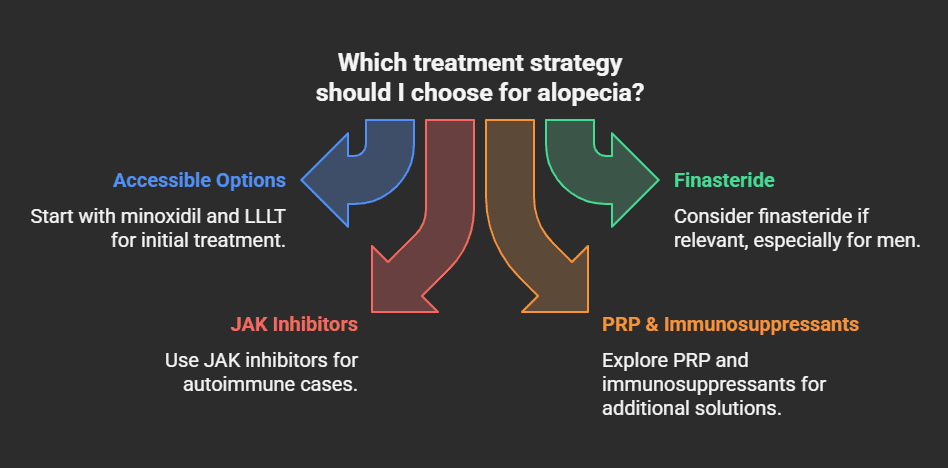Reclaim Your Confidence
Losing your hair, it’s more than skin deep. Self‑esteem takes a hit; mornings feel different. But here’s the thing: you’re not alone. Whether it’s patchy alopecia areata or the classic thinning of androgenetic alopecia, there are proven treatments out there. Let’s dive into the medical options, from tried‑and‑true to cutting‑edge, so you can find what works for you.
Understanding Alopecia Types
Alopecia Areata
An autoimmune trigger attacks hair follicles, leaving sudden bald spots. Sometimes hair grows back on its own within a year. Other times, medical intervention is the game‑changer.
Androgenetic Alopecia (Pattern Baldness)
Genetic and hormonal factors lead to gradual thinning, think receding hairlines or thinning crowns. It affects a wide audience, irrespective of gender.
Knowing which type you’re dealing with is step one in crafting your tailored regrowth plan.
1. Minoxidil (Topical & Oral)
What Is It?
A vasodilator repurposed from blood pressure medicine, now a topical staple that widens vessels, nourishes follicles, and prolongs the growth phase.
Forms & Use
- OTC topical foam or liquid (2% or 5%), applied twice daily
- Low‑dose oral versions (off‑label) available by prescription
Results Timeline
Expect to wait 4–12 months. Stick with it, or you’ll lose any progress.
Side Effects
Scalp irritation is common. Rare side effect: excessive facial hair, especially with tight caps increasing uptake. Oral use ups the risk of unwanted hair elsewhere.
2. Finasteride (Oral/Desktop Combo)
How It Works
Blocks DHT, the hormone that shrinks follicles and triggers male pattern hair loss.
Usage
1 mg daily, men saw 80% improvement after a year versus 52% with topical minoxidil alone.
Side Effects
Some men report mild libido dips or other sexual side effects, but these reversed once treatment stopped.
For Women?
Not FDA-approved for women in pill form. Topical trials are ongoing but still experimental.
3. Low‑Level Laser Therapy (LLLT)
The Device
Comb-based, helmet-style, or cap devices shine red/infrared light onto the scalp to stimulate follicles.
Does It Work?
Studies report improved density and thickness over 3–12 months. It’s safe and side‑effect‑free, but consistency and patience are key.
4. Corticosteroids & Topical Immunotherapy (For Alopecia Areata)
Corticosteroid Injections/Topicals
Injected directly into bald spots, helping to quiet the immune reaction and trigger regrowth.
Immunotherapy
Topical irritants like diphencyprone distract the immune system. Results vary, but it’s a solid option for stubborn spots.
5. JAK Inhibitors (Breakthrough for Alopecia Areata)
What They Do
Target specific immune pathways, shutting down the autoimmune attack at its source.
Approved Options
- Baricitinib (Olumiant): FDA-approved June 2022, effective in moderate to severe cases
- Ritlecitinib (Litfulo): Approved June 2023 for ages 12+, delivering significant regrowth in many
- Deuruxolitinib (Leqselvi): Approved July 2024 for adults with severe cases
Risks & Timeline
Hair regrowth often appears within 4–6 months. Side effects can include infections, blood clots, and high cholesterol, so medical monitoring is essential.
6. Platelet‑Rich Plasma (PRP)
The Process
Your blood is drawn, spun down, and the liquid with growth factors injected into your scalp.
Regrowth & Routine
Three sessions, one month apart, then periodic follow‑ups. Many see density improvement, though long‑term proof is still in progress.
7. Other Systemic Immunosuppressants
Drugs like Methotrexate or Cyclosporine
Reserved for stubborn alopecia areata cases. They can work, but carry significant risks (e.g. liver, kidney, infection), usually paired with steroids.
8. Combination Therapies
Why Combine?
Multiple approaches often deliver better results. For example:
- Minoxidil + Finasteride = stronger together
- Add LLLT or microneedling to enhance results
- PRP + topicals = powerful synergy
Choosing What’s Right for You
- Identify your alopecia type and severity
- Autoimmune? Focus on JAK inhibitors, steroids, immunotherapy, PRP
- Pattern baldness? Start with minoxidil ± finasteride ± LLLT
- Autoimmune? Focus on JAK inhibitors, steroids, immunotherapy, PRP
- Set expectations
- These are long‑term plans, think months, not weeks
- These are long‑term plans, think months, not weeks
- Weigh side effects
- Topicals: irritation or stray facial hair
- Orals: systemic risks
- JAKs: serious monitoring required
- Topicals: irritation or stray facial hair
- Consider cost & accessibility
- OTC options are generally affordable
- Prescription meds, injections, and specialized devices are pricier
- OTC options are generally affordable
Emotional & Practical Support
Hair loss isn’t just cosmetic, it’s emotional. Combine your medical journey with psychological support, peer groups, or supportive counseling. Many find healing in shared stories and hands‑on guidance.
Treatment details
| Treatment Type | Best For | Timeline | Notes & Side Effects |
| Topical Minoxidil | Both types | 4–12 months | Scalp irritation, possible facial hair growth |
| Oral Minoxidil | Off‑label for both | 4–12 months | Potential body hair growth, dose-dependent effects |
| Finasteride | Male pattern baldness | 3–12 months | DHT blocker; mild sexual side effects possible |
| LLLT devices | Both types | 3–12 months | Safe, requires consistency |
| Corticosteroids | Alopecia areata | Weeks–months | Local effects, injection discomfort possible |
| JAK Inhibitors | Severe alopecia areata | 4–6 months | Effective but requires monitoring; costly |
| PRP injections | Both types | Months | Mild, periodic sessions; long‑term data building |
| Systemic Immunosuppressants | Severe alopecia areata | Variable | Significant risks; usually in combination therapy |
Final Takeaway

Treating alopecia isn’t about miracles, it’s about strategy. Start with accessible options like minoxidil and LLLT. Step up to finasteride if relevant (especially for men). For autoimmune cases, JAK inhibitors are transforming outcomes. PRP and immunosuppressants offer added options for those seeking more solutions.
Consistency wins every time. Over time, you’ll likely see thicker hair, and maybe a little boost in confidence, too.
Your Next Steps
- Book an appointment with a board‑certified dermatologist
- Confirm your diagnosis and create a treatment roadmap
- Start with one or two options, then adjust based on results
- Track progress with photos and revisit your plan every 3–6 months








